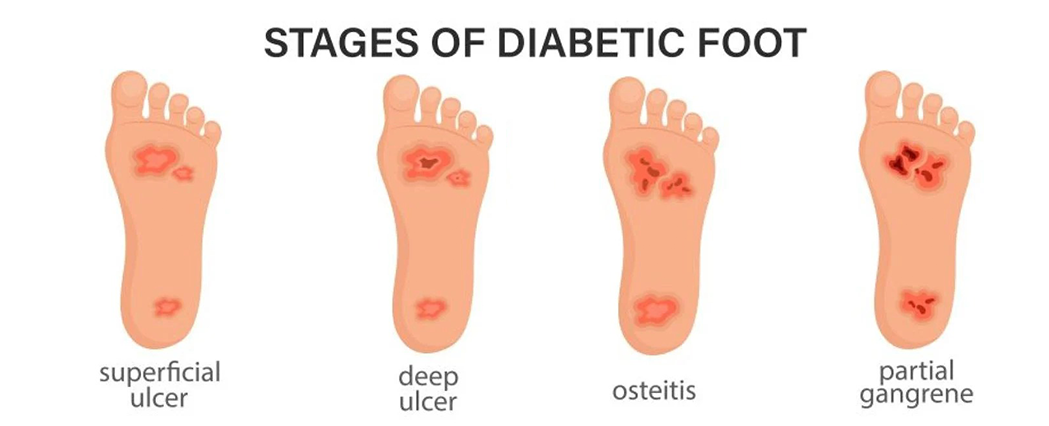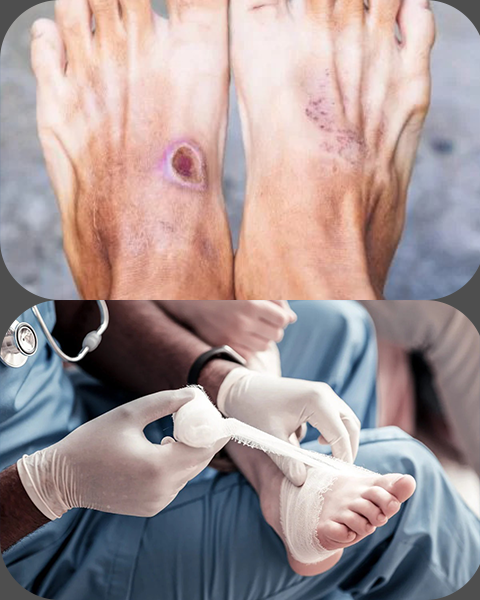DIABETIC FOOT
What is Diabetic Foot?
Diabetic foot refers to a group of foot-related problems that occur in people with diabetes, including poor circulation, nerve damage (neuropathy), foot ulcers, infections, and, in severe cases, risk of amputation. If not managed properly, even a small wound can turn into a serious infection in diabetic patients. Proper care, early detection, and specialized treatment can help prevent complications and protect your feet for life.

Common Diabetic Foot Symptoms
Diabetic foot issues may start mildly and worsen quickly if untreated. Watch out for:
Numbness, tingling, or burning sensation in the feet
Loss of sensation (you may not feel a cut, blister, or burn)
Persistent foot pain or cramps, especially at night
Dry, cracked skin or fungal infections
Corns, calluses, or thickened nails
Open wounds, ulcers, or blackened skin (gangrene)
Swelling, redness, or foul-smelling discharge
What Causes Diabetic Foot?
Diabetic foot problems are caused by a combination of factors related to long-term uncontrolled diabetes:
Peripheral neuropathy: Nerve damage that leads to numbness or loss of sensation in the feet.
Peripheral arterial disease (PAD): Poor blood circulation slows healing and increases risk of infection.
Foot deformities: Changes in foot structure due to nerve damage.
Immune suppression: Higher risk of infections, especially in cuts or blisters.
Neglected foot injuries: Even minor injuries can turn into ulcers or deep infections.
Diabetic Foot Diagnosis
A diabetic foot treatment doctor will begin with a physical examination and a review of your diabetes history to understand any underlying risks. The diagnostic process typically involves a thorough inspection of the foot for signs of wounds, deformities, infections, or poor circulation. To assess nerve damage, tests like the monofilament or tuning fork test may be performed. The doctor will also check the pulse in the foot arteries to evaluate blood flow. Blood tests are often conducted to monitor sugar levels and detect any infection markers. For a more detailed vascular assessment, a Doppler ultrasound or ankle-brachial index (ABI) may be used. If an ulcer appears deep or complicated, imaging studies such as X-rays or MRI might be required to rule out bone infections or abscesses.
Diabetic Foot Treatment
The goal is to prevent complications, promote wound healing, and preserve foot function. Treatment depends on the severity of the condition.
Non-Surgical Treatment Includes:
Blood sugar control – the first and most important step
Wound care – cleaning, dressing, and protecting ulcers
Antibiotics for infected wounds
Footwear modifications to reduce pressure and prevent injuries
Offloading devices like special shoes, insoles, or total contact casts
Pain management for neuropathy
Physiotherapy for mobility support and circulation
Diabetic Foot Care Tips
Inspect your feet daily for cuts, blisters, or color changes.
Wash and moisturize feet daily, especially between toes.
Never walk barefoot, even at home.
Use comfortable, soft, and well-fitted footwear.
Trim nails carefully or have them done by a professional.
Control blood sugar, cholesterol, and blood pressure consistently.
Visit a diabetic foot treatment doctor regularly, even if you feel fine.
When to See a Diabetic Foot Specialist
Seek immediate medical care if you notice:
A wound or ulcer that doesn’t heal
Redness, swelling, or pus discharge
Foul smell from a foot wound
Fever or chills along with foot pain
Black or blue skin patches on the toes or foot
Advanced Diabetic Foot Treatment Options
In severe or complex cases, the following may be required:
Surgical debridement to remove dead tissue
Skin grafting for large or slow-healing wounds
Vascular surgery or angioplasty to improve blood flow
Amputation (only when necessary to prevent life-threatening infection)
Dr. Shakti Swaroop follows a limb-salvage approach and uses the latest wound care techniques to avoid major interventions wherever possible.

Get Expert Diabetic Foot Treatment
If you’re living with diabetes, your feet need regular medical attention. Dr. Shakti Swaroop and his team offer comprehensive care for diabetic foot problems, from early symptom management to advanced wound care and limb preservation strategies.
📞 Book your consultation today for expert diabetic foot treatment in Bhubaneswar and take control of your foot health.
frequently
asked questions
Diabetic foot refers to foot problems caused by high blood sugar, including nerve damage, poor circulation, ulcers, and infections. It is dangerous because a minor injury can quickly turn into a serious wound or infection, potentially leading to amputation if not treated in time.
Keep your blood sugar under control, inspect your feet daily, wear protective footwear, avoid walking barefoot, and see a diabetic foot specialist regularly. Early care prevents most complications.
You should seek diabetic foot treatment if you notice any wound, ulcer, swelling, discolouration, numbness, pain, or discharge in your foot. Delaying treatment can increase the risk of serious infection.
Basic treatment like dressing changes, offloading, and medications are generally not painful. If advanced procedures are needed, pain management is always part of the care plan.
For reliable and expert diabetic foot treatment in Bhubaneswar, Dr. Shakti Swaroop offers advanced wound care, vascular assessments, and customized treatment plans to protect and preserve your feet. Book your appointment today for compassionate care.
